Lancia Ypsilon 2018 Owner handbook (in English)
Manufacturer: LANCIA, Model Year: 2018, Model line: Ypsilon, Model: Lancia Ypsilon 2018Pages: 200, PDF Size: 4.53 MB
Page 61 of 200

Warning light What it means
iTPMS
(for versions/markets, where provided)
Tyre pressure low
The warning light (or symbol for versions with multifunction reconfigurable display) switches on constantly
to indicate that the tyre pressure is lower than the recommended value, in order to guarantee long tyre life
and low fuel consumption, or to indicate a slow loss of pressure.
In this way the iTPMS warns the driver that one or more tyres may be flat and probably punctured. In this
case it is advisable to restore the correct pressure value. Once the normal operating conditions of the
vehicle are restored, carry out the Tyre reset procedure.
IMPORTANT Do not continue driving with one or more flat tyres as handling may be compromised. Stop
the vehicle, avoiding sharp braking and steering.
iTPMS failure/iTPMS temporarily deactivated
The warning light (or symbol for versions with multifunction reconfigurable display) flashes for about 75
seconds and then stays on constantly (along with a dedicated message on the display) to indicate that the
system is temporarily deactivated or faulty. The system goes back to normal operation when the operating
conditions allow it. If this is not the case, carry out the Tyre reset procedure after restoring the normal
operating conditions.
If the malfunction warning persists, contact a Lancia Dealership as soon as possible.
59
Page 62 of 200
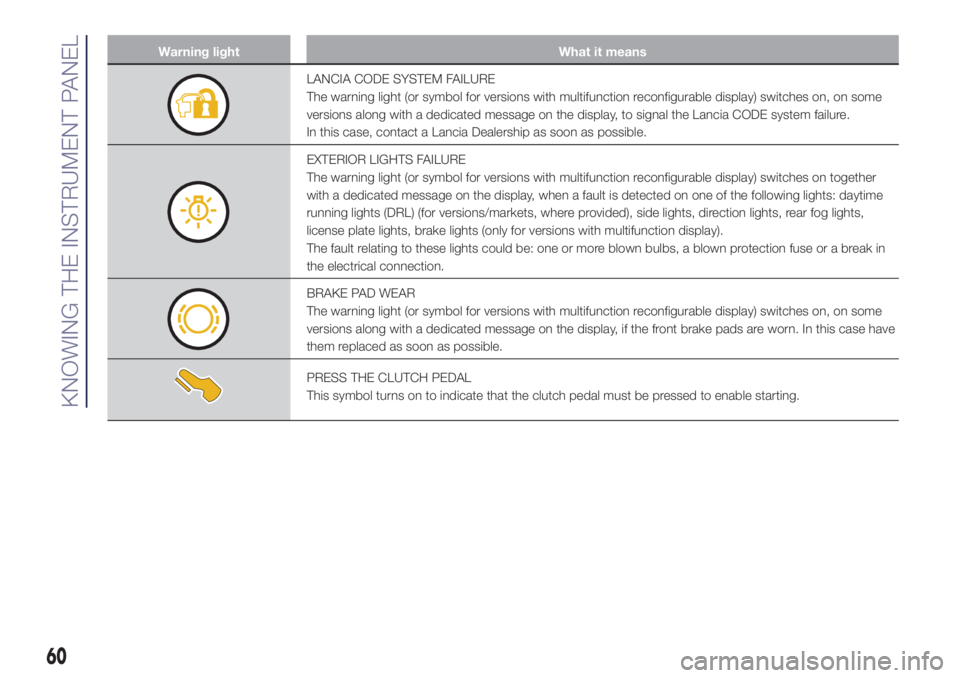
Warning light What it means
LANCIA CODE SYSTEM FAILURE
The warning light (or symbol for versions with multifunction reconfigurable display) switches on, on some
versions along with a dedicated message on the display, to signal the Lancia CODE system failure.
In this case, contact a Lancia Dealership as soon as possible.
EXTERIOR LIGHTS FAILURE
The warning light (or symbol for versions with multifunction reconfigurable display) switches on together
with a dedicated message on the display, when a fault is detected on one of the following lights: daytime
running lights (DRL) (for versions/markets, where provided), side lights, direction lights, rear fog lights,
license plate lights, brake lights (only for versions with multifunction display).
The fault relating to these lights could be: one or more blown bulbs, a blown protection fuse or a break in
the electrical connection.
BRAKE PAD WEAR
The warning light (or symbol for versions with multifunction reconfigurable display) switches on, on some
versions along with a dedicated message on the display, if the front brake pads are worn. In this case have
them replaced as soon as possible.
PRESS THE CLUTCH PEDAL
This symbol turns on to indicate that the clutch pedal must be pressed to enable starting.
60
KNOWING THE INSTRUMENT PANEL
Page 63 of 200

Green warning lights / symbols
Warning light What it means
FOG LIGHTS
The warning light comes on when the front fog lights are turned on. The LED over the button
will also
light up.
SIDE LIGHTS AND DIPPED BEAM HEADLIGHTS/FOLLOW ME HOME
Side lights and dipped beam headlights
The warning light switches on when the side lights or dipped headlights are turned on.
Follow Me Home
The warning light comes on, on some versions along with a dedicated message on the display, when the
"Follow me home" device is used.
LEFT DIRECTION INDICATOR
The warning light turns on when the direction indicator control lever is moved downwards or, together with
the right indicator, when the hazard warning light button is pressed.
RIGHT DIRECTION INDICATOR
The warning light turns on when the direction indicator control lever is moved upwards or, together with the
left indicator, when the hazard warning light button is pressed.
61
Page 64 of 200
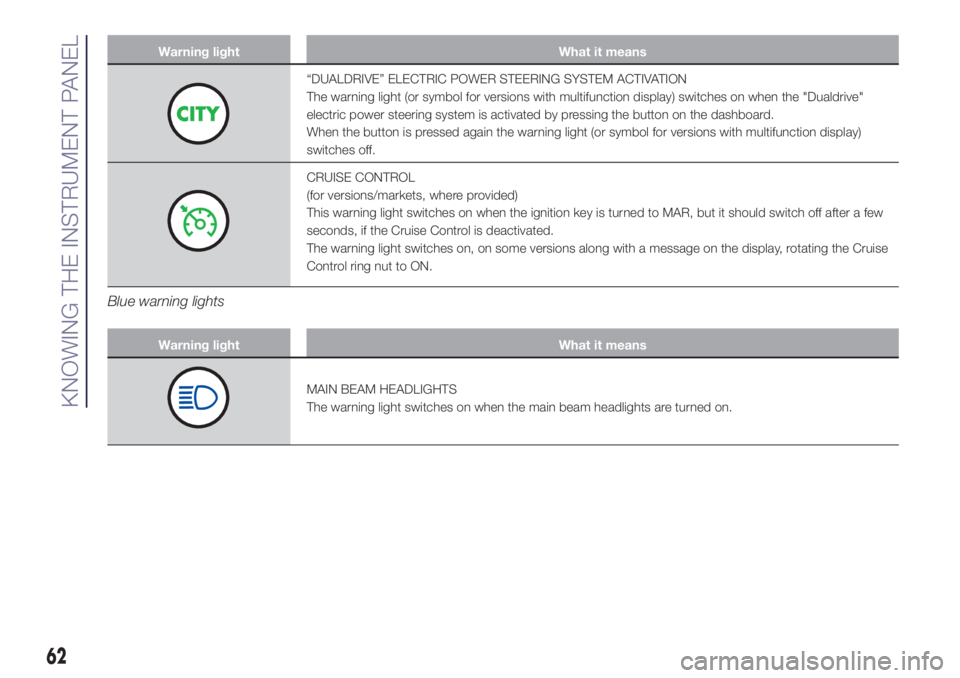
Warning light What it means
“DUALDRIVE” ELECTRIC POWER STEERING SYSTEM ACTIVATION
The warning light (or symbol for versions with multifunction display) switches on when the "Dualdrive"
electric power steering system is activated by pressing the button on the dashboard.
When the button is pressed again the warning light (or symbol for versions with multifunction display)
switches off.
CRUISE CONTROL
(for versions/markets, where provided)
This warning light switches on when the ignition key is turned to MAR, but it should switch off after a few
seconds, if the Cruise Control is deactivated.
The warning light switches on, on some versions along with a message on the display, rotating the Cruise
Control ring nut to ON.
Blue warning lights
Warning light What it means
MAIN BEAM HEADLIGHTS
The warning light switches on when the main beam headlights are turned on.
62
KNOWING THE INSTRUMENT PANEL
Page 65 of 200

SYMBOLS AND MESSAGES ON THE DISPLAY
Symbols and Messages What it means
POSSIBLE ICE ON ROAD
(for versions/markets, where provided)
On versions equipped with "reconfigurable multifunction display", a message together with
a symbol will appear on the display when the outdoor temperature falls to, or is below,
3°C.
IMPORTANT In the event of outside temperature sensor failure, dashes are shown on the
display instead of the value.
ASR SYSTEM DEACTIVATION
The ASR system can be deactivated by pressing the ASR OFF button.
On versions equipped with reconfigurable multifunction display, the system deactivation is
indicated by the displaying of a dedicated message and a symbol on the display; at the
same time the LED on the ASR OFF button switches on.
PETROL/METHANE SWITCHING
(for versions/markets, where provided)
Warning light on constantly: methane operation.
Warning light off: petrol operation.
The symbol is displayed, along with a dedicated message, in the event of a methane
supply system failure.
In this case, contact a Lancia Dealership as soon as possible, running on petrol
START&STOP SYSTEM ACTIVATION/
DEACTIVATIONStart&Stop system activation
A message will appear on the display when the Start&Stop system is activated.
In this condition the LED on the
button located on the dashboard control panel is off.
Start&Stop system deactivation
The Start & Stop system deactivation is indicated by a message on the display and, for
versions with reconfigurable multifunction display, by the
symbol that switches on.
The LED above the
button is on when the system is deactivated.
63
Page 66 of 200

Symbols and Messages What it means
START&STOP SYSTEM FAILUREThe Start&Stop system failure is indicated by a message on the display and by the
warning light (or symbol)on the instrument panel that switches on.
In the event of a Start&Stop system failure, contact a Lancia Dealership.
ECO FUNCTION ACTIVATION/DEACTIVATION
(0.9 TwinAir 85 HP versions)The ECO function activation/deactivation, by pressing the button on the dashboard, is
indicated by a dedicated message on the display.
SERVICE (SCHEDULED SERVICING) EXPIREDWhen the scheduled servicing is nearly due ("scheduled service deadline"), the display will
show the symbol followed by the number of kilometres/miles until the car must be
serviced. This is displayed automatically, with ignition key at MAR-ON, 2000 km (or
equivalent value in miles) before servicing or, where provided, 30 days before servicing. It is
also displayed each time the key is turned to MAR-ON or, for versions/markets, where
provided, every 200 km (or equivalent value in miles).
Contact a Lancia Dealership where the operations of the "Scheduled Servicing Plan" will
be performed and the message will be reset.
DUAL FUNCTION SYSTEM GEARBOX
MESSAGESFor versions equipped with "Dual Function System" gearbox, the following messages can
be displayed:
Reduce gear changes message
Manual mode not available message
Automatic mode not available message
Clutch overheating message
Press the brake pedal message
Press the brake pedal - delayed start-up message
Press brake and repeat manoeuvre message
Gear not available message
Manoeuvre not permitted message
Place gear lever in N (neutral) message
64
KNOWING THE INSTRUMENT PANEL
Page 67 of 200
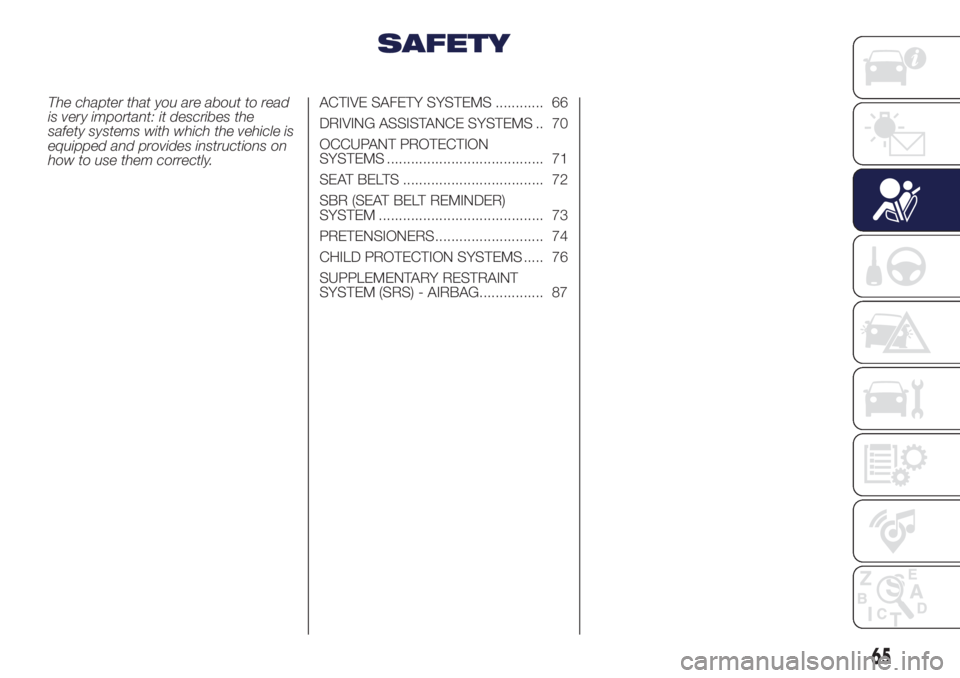
SAFETY
The chapter that you are about to read
is very important: it describes the
safety systems with which the vehicle is
equipped and provides instructions on
how to use them correctly.ACTIVE SAFETY SYSTEMS ............ 66
DRIVING ASSISTANCE SYSTEMS .. 70
OCCUPANT PROTECTION
SYSTEMS ....................................... 71
SEAT BELTS ................................... 72
SBR (SEAT BELT REMINDER)
SYSTEM ......................................... 73
PRETENSIONERS........................... 74
CHILD PROTECTION SYSTEMS ..... 76
SUPPLEMENTARY RESTRAINT
SYSTEM (SRS) - AIRBAG................ 87
65
Page 68 of 200
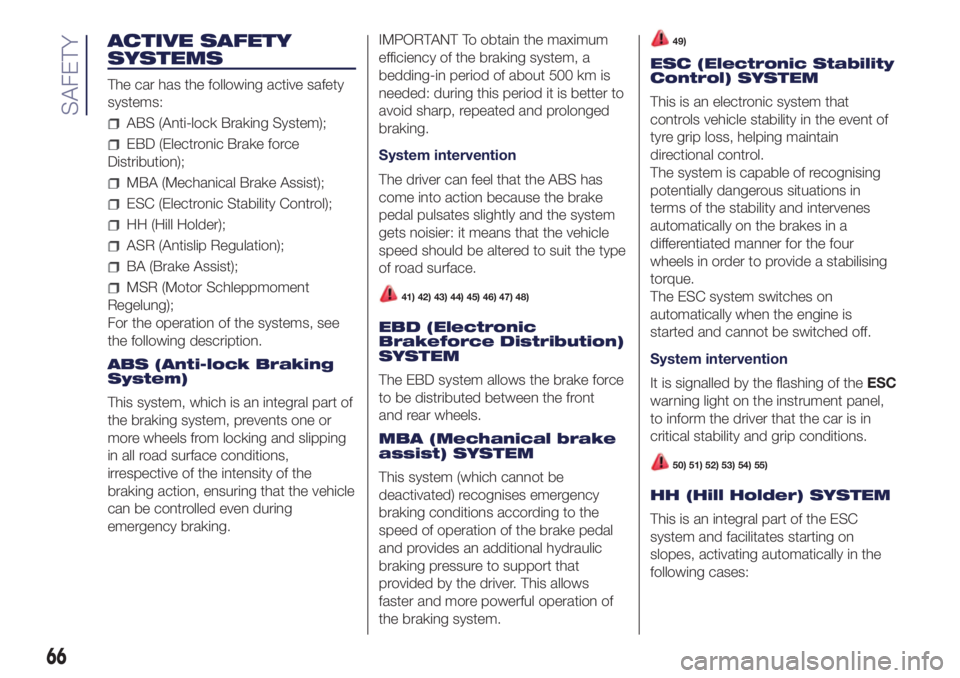
ACTIVE SAFETY
SYSTEMS
The car has the following active safety
systems:
ABS (Anti-lock Braking System);
EBD (Electronic Brake force
Distribution);
MBA (Mechanical Brake Assist);
ESC (Electronic Stability Control);
HH (Hill Holder);
ASR (Antislip Regulation);
BA (Brake Assist);
MSR (Motor Schleppmoment
Regelung);
For the operation of the systems, see
the following description.
ABS (Anti-lock Braking
System)
This system, which is an integral part of
the braking system, prevents one or
more wheels from locking and slipping
in all road surface conditions,
irrespective of the intensity of the
braking action, ensuring that the vehicle
can be controlled even during
emergency braking.IMPORTANT To obtain the maximum
efficiency of the braking system, a
bedding-in period of about 500 km is
needed: during this period it is better to
avoid sharp, repeated and prolonged
braking.
System intervention
The driver can feel that the ABS has
come into action because the brake
pedal pulsates slightly and the system
gets noisier: it means that the vehicle
speed should be altered to suit the type
of road surface.41) 42) 43) 44) 45) 46) 47) 48)
EBD (Electronic
Brakeforce Distribution)
SYSTEM
The EBD system allows the brake force
to be distributed between the front
and rear wheels.
MBA (Mechanical brake
assist) SYSTEM
This system (which cannot be
deactivated) recognises emergency
braking conditions according to the
speed of operation of the brake pedal
and provides an additional hydraulic
braking pressure to support that
provided by the driver. This allows
faster and more powerful operation of
the braking system.
49)
ESC (Electronic Stability
Control) SYSTEM
This is an electronic system that
controls vehicle stability in the event of
tyre grip loss, helping maintain
directional control.
The system is capable of recognising
potentially dangerous situations in
terms of the stability and intervenes
automatically on the brakes in a
differentiated manner for the four
wheels in order to provide a stabilising
torque.
The ESC system switches on
automatically when the engine is
started and cannot be switched off.
System intervention
It is signalled by the flashing of theESC
warning light on the instrument panel,
to inform the driver that the car is in
critical stability and grip conditions.
50) 51) 52) 53) 54) 55)
HH (Hill Holder) SYSTEM
This is an integral part of the ESC
system and facilitates starting on
slopes, activating automatically in the
following cases:
66
SAFETY
Page 69 of 200
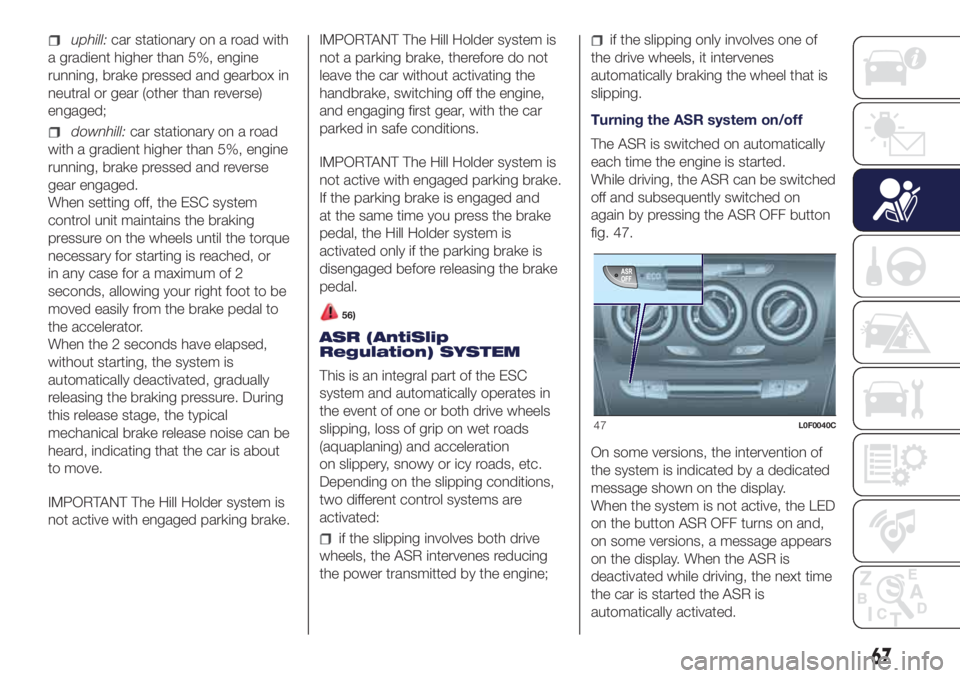
uphill:car stationary on a road with
a gradient higher than 5%, engine
running, brake pressed and gearbox in
neutral or gear (other than reverse)
engaged;
downhill:car stationary on a road
with a gradient higher than 5%, engine
running, brake pressed and reverse
gear engaged.
When setting off, the ESC system
control unit maintains the braking
pressure on the wheels until the torque
necessary for starting is reached, or
in any case for a maximum of 2
seconds, allowing your right foot to be
moved easily from the brake pedal to
the accelerator.
When the 2 seconds have elapsed,
without starting, the system is
automatically deactivated, gradually
releasing the braking pressure. During
this release stage, the typical
mechanical brake release noise can be
heard, indicating that the car is about
to move.
IMPORTANT The Hill Holder system is
not active with engaged parking brake.IMPORTANT The Hill Holder system is
not a parking brake, therefore do not
leave the car without activating the
handbrake, switching off the engine,
and engaging first gear, with the car
parked in safe conditions.
IMPORTANT The Hill Holder system is
not active with engaged parking brake.
If the parking brake is engaged and
at the same time you press the brake
pedal, the Hill Holder system is
activated only if the parking brake is
disengaged before releasing the brake
pedal.
56)
ASR (AntiSlip
Regulation) SYSTEM
This is an integral part of the ESC
system and automatically operates in
the event of one or both drive wheels
slipping, loss of grip on wet roads
(aquaplaning) and acceleration
on slippery, snowy or icy roads, etc.
Depending on the slipping conditions,
two different control systems are
activated:
if the slipping involves both drive
wheels, the ASR intervenes reducing
the power transmitted by the engine;
if the slipping only involves one of
the drive wheels, it intervenes
automatically braking the wheel that is
slipping.
Turning the ASR system on/off
The ASR is switched on automatically
each time the engine is started.
While driving, the ASR can be switched
off and subsequently switched on
again by pressing the ASR OFF button
fig. 47.
On some versions, the intervention of
the system is indicated by a dedicated
message shown on the display.
When the system is not active, the LED
on the button ASR OFF turns on and,
on some versions, a message appears
on the display. When the ASR is
deactivated while driving, the next time
the car is started the ASR is
automatically activated.
47L0F0040C
67
Page 70 of 200

When travelling on snowy roads with
snow chains, it may be helpful to turn
the ASR off: in fact, in these conditions,
the driving wheels skidding when
moving off gives you better traction.
57) 58) 60) 60) 61) 62)
BA (Brake Assist)
SYSTEM
The system, which cannot be turned
off, recognises emergency braking (on
the basis of the brake pedal operating
speed) and speeding up the response
of the braking system. The Brake Assist
device is deactivated if there is a ESC
system failure.
MSR (Motor
Schleppmoment
Regelung) SYSTEM
This system is an integral part of the
ABS that intervenes, if there is a
sudden downshifting, restoring torque
to the engine, thereby preventing
excessive drive at the drive wheels
which, especially in poor grip
conditions, could lead to a loss in
stability of the car.HBA (Hydraulic Brake
Assist) SYSTEM
It is an integral part of the ESC system.
The HBA system is designed to
improve the car’s braking capacity
during emergency braking.
The system detects an emergency
braking by monitoring the speed and
strength with which the brake pedal
is pressed, thereby applying the optimal
brake pressure. This can reduce the
braking distance: the HBA system
therefore completes the ABS.
Maximum assistance of the HBA
system is obtained pressing the brake
pedal very quickly; in addition, the
brake pedal should be pressed
continuously during braking, avoiding
intermittent presses, to obtain benefits
from the system.
Do not reduce pressure on the brake
pedal until braking is no longer
necessary.
The HBA system is deactivated when
the brake pedal is released.
63) 64) 65) 66)
WARNING
41)The ABS gets the most from the
available grip, but it cannot improve it; you
should therefore take every care when
driving on slippery surfaces and not take
unnecessary risks.
42)When the ABS cuts in and you feel the
brake pedal pulsating, do not remove
your foot, but keep the pedal pushed
down; in doing so you, will stop in the
shortest distance possible under the road
conditions at the time.
43)If the ABS system intervenes, this
indicates that the traction of the tyres on
the road is nearing its limit. You must slow
down to a speed compatible with the
available traction.
44)The ABS cannot overrule the natural
laws of physics, and cannot increase
the grip available according to the
condition of the road.
45)The ABS cannot prevent accidents,
including those due to excessive speed on
corners, driving on low-grip surfaces or
aquaplaning.
46)The capability of the ABS must never
be tested irresponsibly and dangerously, in
such a way as to compromise personal
safety and the safety of others.
47)For the correct operation of the ABS,
the tyres must of necessity be the same
make and type on all wheels, in perfect
condition and, above all, of the prescribed
type and dimensions.
68
SAFETY